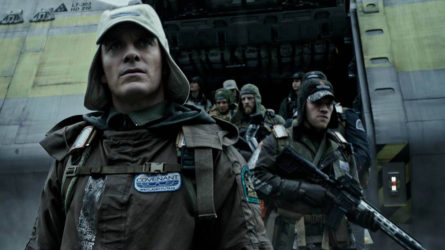The Humanities, at its best, teaches us to think and to consider the act of creativity. Alien: Covenant, director Ridley Scott’s new film, is consumed with thought and creation and becomes an ode that descends into a requiem. The ode to the power of the creative marks itself in the way the film interacts with the Arts. The Humanities student in me was intrigued by the way that musings on Art mark essential plot points in the film. A short prologue at the beginning of the film (set before the events of the previous instalment in the series, Prometheus) sees the moment where the android David, played by Michael Fassbender, comes to sentience, choosing his name from a Michelangelo sculpture.

This sets the tone for what follows. David can live forever, unlike the human who created him, but he cannot create – a painting, a sculpture, a poem. It’s why he’s so drawn to the aliens that grow out of the humans. He wants the ability to have something to call his own. It’s an ironically human desire. Stephen Sondheim once wrote that the only thing humans have to pass down is children or art. David can technically create neither but uses the aliens as a terrifying mixture of both. It’s why the film depends so elegantly on set-pieces devoted to literature and art, which are key facets of the Humanities.
You need not have seen any of the previous instalments to watch the new Alien film, although foreknowledge – of Prometheus, specifically – helps. That film followed a team of scientists journeying to a distant moon, where they discover biological weapons that could make the human race extinct. Prometheus ends with two characters surviving. The events of Covenant take place 30 years after that, filling in some gaps but offering more questions than anything else. The interrogative nature of the film is deliberate and explicit and it benefits from foreknowledge, not just of its world but our own world.
In the new film, a colony ship, with a crew comprising married couples, is seeking a new world. The religious parallels abound as much as the literary. The ship, which alludes to Noah’s ark, is travelling with about 2,000 sleeping colonists and 1,000 embryos to seek a new civilisation on a distant planet. Its seven-year long journey is interrupted when a neutrino burst hits the ship, killing the captain and alerting the crew to evidence of human life nearby, where there should be none. They head to this seemingly promising planet and, naturally, disaster strikes. This is an Alien movie, after all. Yet, Covenant subverts, at least initially, the expected scares and settles instead for something plaintive and humane, especially throughout its first hour.
Here’s some literary knowledge that Scott seems to directly invoke in Covenant: Lord Byron, John Polidori, Percy Shelley and Mary Shelley had a competition trying to come up with the greatest horror story. Mary Shelley, after some days, came up with the idea of a scientist who created life and was horrified and wrecked by his creation. It became the novel called Frankenstein, which is the prototypical story upon which any film on android and human interaction builds.
Mary’s husband, Percy, was a poet most remembered for a sonnet borne out of another competition. Percy Shelley and Horace Smith, another poet, were drawn to a fragment of a statue from 13 BC with the inscription: “King of Kings Ozymandias am I. If any want to know how great I am and where I lie, let him outdo me in my work.” The arrogant words of a creator, who is doomed to die, having false faith in his superiority, inspired Shelley’s poem “Ozymandias,” which is quoted in a thrilling set-piece in Covenant.
I mention this literary diversion not incidentally, because the celebration of Art and Literature in all their aesthetic pleasure marks a main aspect of this film, which makes for an unusual sci-fi entry. The competitive nature of creation is marked in the way the team on board interacts with each other. The human crew is intrigued with the extra-terrestrial things they come across, whereas David, the android, is obsessed with the traditional art forms – poetry, music, sculpture. The film’s best scene is completely devoid of plot and instead is a vaguely sexual, mostly philosophical bit of seduction as two androids David and Walter (both played by Fassbender) play a flute together. The flute’s existence as a phallic symbol is not accidental.
The scene betrays, like many parts of the film, that Covenant works best when it allows Scott to be the aesthete that he is. Scott’s main inclinations are not to create something new, necessarily, but to tenderly observe the things that already are. The most beautiful sequences in the film are those which allow Scott to observe the world around him in its grandeur, focused more on thoughtful exploration than exposition. This sort of thoughtful exploration works best in the first hour, where the cast is asked to just exist as humans within a fickle world rather than be stand-ins for the essential plot twists that will occur later on. When the showdowns between Walter and David, two androids on different moral planes, come, the audience expects it. Walter and David are opposite aspects of the android in this world where the ability to create is paramount and the film immediately sets up where it intends to go with this, revealing a view of the world that’s incredibly hopeless even as it is continuously compelling to watch. Humanity may be doomed to die, but what beautiful music we make while we live.
Have a comment? Write to Andrew at almasydk@gmail.com




